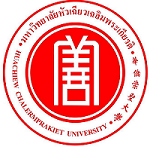Please use this identifier to cite or link to this item:
https://has.hcu.ac.th/jspui/handle/123456789/4290Full metadata record
| DC Field | Value | Language |
|---|---|---|
| dc.contributor.author | นริศ วศินานนท์ | - |
| dc.contributor.author | สุกัญญา วศินานนท์ | - |
| dc.contributor.author | Naris Wasinanon | - |
| dc.contributor.author | Sukanya Wasinanon | - |
| dc.contributor.author | 何福祥 | - |
| dc.contributor.author | 黄如侬 | - |
| dc.contributor.other | Huachiew Chalermprakiet University. College of Chinese Studies | en |
| dc.contributor.other | Independent Scholar | en |
| dc.date.accessioned | 2025-07-10T14:25:47Z | - |
| dc.date.available | 2025-07-10T14:25:47Z | - |
| dc.date.issued | 2025 | - |
| dc.identifier.citation | วารสารวิชาการภาษาและวัฒนธรรมจีน 12,1 (มกราคม-มิถุนายน 2568) : 77-91. | en |
| dc.identifier.uri | https://has.hcu.ac.th/jspui/handle/123456789/4290 | - |
| dc.description | สามารถเข้าถึงบทความฉบับเต็ม (Full Text) ได้ที่ : https://so02.tci-thaijo.org/index.php/clcjn/article/view/278140/185604 | en |
| dc.description.abstract | บทความ วิชาการ นี้เป็นการอธิบายถึงอักษรยืมใช้ (假借字) ซึ่งเป็นรูปแบบหนึ่งของวิธี สร้างอักษรจีน 6 แบบ (六书) ในสมัยโบราณแท้จริงแล้วอักษรยืมใช้เป็นรูปแบบการใช้อักษรจีนเท่านั้นไม่ใช่วิธีการสร้างอักษรปัจจุบันแม้ว่าจะไม่มีการใช้อักษรจีนรูปแบบนี้แล้วแต่อักษรยืมใช้ก็ยังมีปรากฏอยู่ในภาษาจีนปัจจุบันและมีจํานวนไม่น้อยที่เป็นตัวอักษรจีน ใช้บ่อย บทความนี้จึงได้อธิบายประเด็นของคําจํากัดความและลักษณะเด่นของอักษรยืมใช้ รูปแบบของอักษรยืมใช้ความสัมพันธ์ด้านรูปลักษณ์ เสียง อ่านและความหมายของอักษรยืมใช้กับอักษรสร้างใหม่ รวมถึงให้ ข้อเสนอแนะเกี่ยวกับการเรียนการสอนอักษรยืมใช้ โดยผู้เขียนเห็นว่าการเรียนสอนภาษาจีนหรือการสอนอักษรจีนนั้นไม่ควรมองข้ามการให้ความรู้เกี่ยวกับอักษรยืมใช้ แต่ควรให้ความสําคัญกับการอธิบายให้เข้าใจและเกิดการคิดเชื่อมโยงในเรื่องความสัมพันธ์ ด้านรูปลักษณ์ เสียง อ่านและ ความหมายของอักษรยืมใช้กับ อักษรสร้างใหม่ทั้งนี้เพื่อช่วยให้ผู้เรียนสามารถจดจําตัวอักษรจีนเหล่านี้ได้ง่าย และรวดเร็วอีกทั้งยังช่วยเพิ่มพูน คําศัพท์ให้แก่ผู้เรียนอีกด้วย | en |
| dc.description.abstract | This article explains phonetic loan characters (假借字), one of the six categories of Chinese characters construction (六书) in ancient China. In reality, phonetic loan characters represent a way of using existing Chinese characters rather than a method of creating new ones. Although this category is no longer actively used, phonetic loan characters still exist in modern Chinese, and many of them are frequently used. The article discusses the definition and distinctive characteristics of phonetic loan characters, their various forms, and the relationships between their structure, pronunciation, and meaning in comparison with newly created characters. Additionally, it offers suggestions for teaching phonetic loan character and emphasizes that Chinese language instruction, particularly the teaching of Chinese characters, should not overlook the importance of providing knowledge about these characters. Instead, educators shouldfocus on helping learners understand and make connections between thestructure, pronunciation, and meaning of phonetic loan characters and those of newly created characters. This approach not only enhance learners’ability to memorize Chinese characters more easily and efficiently, but also expands their vocabulary. | en |
| dc.language.iso | th | en |
| dc.subject | ตัวอักษรจีน | en |
| dc.subject | 汉字 | en |
| dc.subject | Chinese characters | en |
| dc.subject | ภาษาจีน -- ตัวอักษร | en |
| dc.subject | Chinese language -- Alphabet | en |
| dc.subject | 汉语 -- 字母 | en |
| dc.subject | ภาษาจีน -- การศึกษาและการสอน | en |
| dc.subject | 汉语 -- 学习和教学 | en |
| dc.subject | Chinese language -- Study and teaching | en |
| dc.subject | ภาษาจีน -- คำยืม | en |
| dc.subject | Chinese language -- Foreign word and phrases | en |
| dc.subject | 汉语 -- 外来语 | - |
| dc.subject | Loanwords | - |
| dc.subject | 假借字 | - |
| dc.title | “อักษรยืมใช้”กับการเรียนการสอนภาษาจีน | en |
| dc.title.alternative | Phonetic Loan Characters and Chinese Language Teaching | en |
| dc.type | Article | en |
| Appears in Collections: | College Of Chinese Studies - Articles Journals | |
Files in This Item:
| File | Description | Size | Format | |
|---|---|---|---|---|
| Phonetic-Loan-Characters-and-Chinese-Language-Teaching.pdf | 80.75 kB | Adobe PDF | View/Open |
Items in DSpace are protected by copyright, with all rights reserved, unless otherwise indicated.
